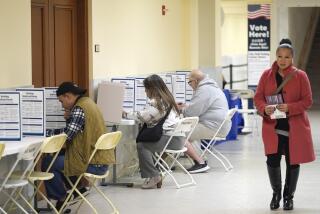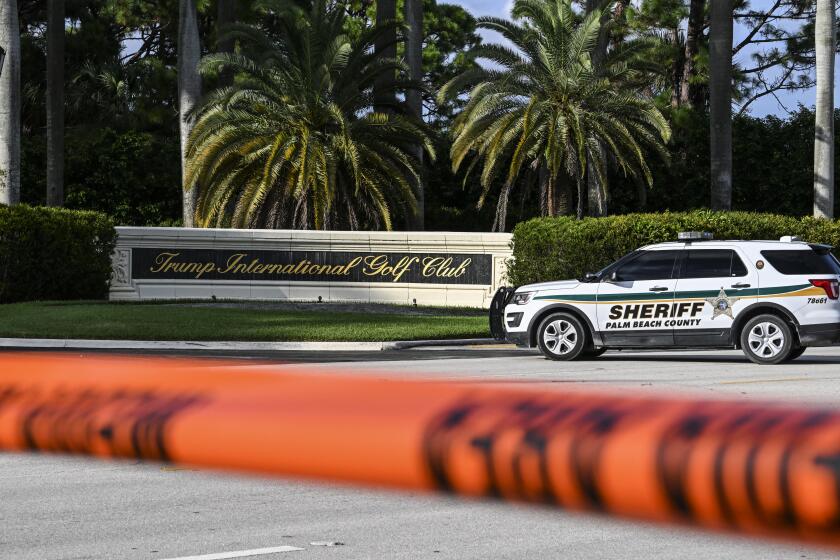Wars Take Some Nasty Turns on City Streets
If American and British forces move into the streets of Baghdad, they may face a form of battle that armies have dreaded for centuries: Of all the places to fight, a city is one of the most dangerous.
“If troops are attacking cities, their strength will be exhausted,” the Chinese strategist Sun Tzu wrote about 2,500 years ago. “The worst policy is to attack cities. Attack cities only when there is no alternative.”
In urban areas, buildings obscure sight lines. Curtained windows hide sniper nests. Alleyways present a confusing maze to outsiders but give cover to hometown fighters for hit-and-run strikes. It can be maddeningly difficult to distinguish civilians from enemy combatants.
And from the Russians in Chechnya to the Israelis in the West Bank and U.S. forces at Hue in Vietnam, new generations of soldiers have learned that cities can be bewildering battlefields.
“It’s the hardest fight of all,” said Douglas V. Johnson II, research professor at the U.S. Army War College in Carlisle, Pa. “The urban fight costs you more casualties than anything else.”
If American and British forces enter Baghdad for a strike at the heart of Saddam Hussein’s power, they hope to have already eased their entry by crushing Republican Guard troops outside the Iraqi capital, which in turn might prompt a military collapse. American forces have also improved their training, tactics and equipment for urban warfare in recent years, for example, carrying tougher body armor, more-accurate rifles and better radios that help squads work together.
Still, experts have long worried that a battle for Baghdad could produce a bloodbath and a public relations disaster.
Combat in Baghdad could be a “nightmare scenario,” retired Marine Gen. Joseph Hoar, a former chief of the U.S. Central Command, said in testimony before a Senate committee in September. “In urban warfare, you could run through battalions a day at a time ... that are just combat-ineffective because of casualties. This is very slow going.”
Baghdad, with about 5 million residents, is free of some of the toughest hazards of urban warfare. A sprawling city of low buildings, it lacks the “urban canyons” of adjacent skyscrapers that can become prime ambush zones for invading forces. Broad boulevards provide handy routes to the city center.
But its huge dimensions could make it a tough city to hold, said Joseph Wilson IV, who was chief of mission at the U.S. Embassy in Baghdad from 1988 to 1991.
“Baghdad is roughly the area of Los Angeles,” Wilson said. “It is so widespread that it would be hard to police all the pockets of potential resistance. It’s going to be a difficult city to occupy if there is any resistance at all.”
Wilson said one key city feature -- the Tigris River -- could favor the Americans and British. “It meanders through the city and makes a big U-turn right in the middle,” he said. “When the bridges go, getting from one side of the city to the other becomes a problem, but we, being more mobile, will not be as troubled as the Iraqi defenders.”
Military officials say that in the first stage of a U.S.-led attack on Baghdad, a contingent of combat engineers would be sent in, supported by infantry, to clear away any roadblocks that might bar the intended path through the city.
Next, teams of tanks and troops on foot would move together through the city, with attack helicopters providing supporting machine gun and missile fire.
The tanks would protect the foot soldiers by destroying any hidden fighters who tried to pin troops down with heavy fire. The infantry would support the tanks by rooting out hidden adversaries who might be armed with antitank missiles.
U.S. commanders say they want to avoid heavy building-to-building fighting. They plan to try to knock out the regime’s key assets -- headquarters, communications centers and supply and ammunition depots -- ahead of time.
Still, for many troops, an urban fight would mean moving by foot through hostile streets, much like city battles of decades ago.
“What it still comes down to is people with their nerves at absolute fever pitch and fear in every pore of their body, pressing forward and hoping that there isn’t anybody around the next corner -- or, if there is, that they can fire before the other guy can,” Johnson said.
A Walk Like No Other
Troops who have walked through foreign streets and alleys in a combat zone say their senses went on high alert, tuned for signals that might come from anywhere: above, behind or below. At the same time, some say, they tried to drain themselves of humanity so that they could react without emotion, relying purely on their training.
In 1993, Army Rangers and Delta Force troops had moved into Mogadishu, Somalia’s capital, to try to capture lieutenants of warlord Mohammed Farah Aidid. But when two U.S. helicopters were downed in the process, the soldiers had to find and rescue their colleagues amid harassment from angry crowds armed with automatic weapons and grenades.
“You’d see women in front of you, and you’d hear shooting from that direction. The men would take rifles and put them under the armpits of the women,” said Peter Squeglia, who was 25 at the time of the battle.
At one point, “there were five little kids sharing one AK-47 between them, firing at our positions,” Squeglia said. He guessed that the boys were between 10 and 12 years old.
Soldiers shot a boy who was holding the rifle, then had to shoot a second and third as each picked up the weapon in turn. “One kid fell and the next one picked up the rifle,” Squeglia said. “And I remember, the fifth one was smart enough not to pick it up.”
The following day, Army Cpl. Philip Lepre Jr. found himself in the chaos of an alleyway in Mogadishu. With men screaming threats, women in torn dresses and flip-flops and even waist-high boys surging toward him, the 24-year-old explosives specialist could not tell who was intent on real harm and who might have been innocently swept up in the crowd.
Lepre’s job was to keep the crowd at bay, “and that meant everybody,” he recalled. And so he fired -- on all of them. Several people dropped, including women. “You have to react first,” he said. “One second could cost you your life.”
To handle the stress of the situation, Lepre said, he tried to convince himself that he was already dead.
“Stay numb,” said Dale Sizemore, then a 21-year-old Army Ranger involved in the Mogadishu fight. It was the only way to face an adversary who often used women and children as shields -- or even as combatants.
The Somalia mission began as a high-minded effort to feed a war-torn nation and ended in the deaths of dozens of U.S. troops and hundreds of Somalis. It was the subject of the movie “Black Hawk Down.”
Even when there is high attention to protecting civilians -- a practice that U.S. officials say they bring to the fighting in Iraq -- the close quarters of urban combat makes injuries and deaths hard to avoid.
Israeli forces, for example, say they do what they can to avoid civilian casualties in clashes with Palestinians. But some deaths are the result of errors made under pressure.
“During a very dangerous operation, when my men were under fire as they approached a house, there was a lull in the firing,” said one Israeli brigade commander, whose territory included the West Bank city of Jenin. Suddenly, the soldiers heard a loud bang as a man in an adjoining house opened his shutter to see what was happening.
“A soldier immediately reacted and fired, and the man, an innocent civilian, was killed,” said the commander, who spoke anonymously in accordance with military regulations. “These are the kinds of things that can happen even when the best of care is being taken.”
In the Iraq war, U.S. officials have claimed that Iraqi fighters have dressed in civilian clothes and feigned surrender in attempts to kill American and British troops. Experts say that indicates that similar techniques would be used in Baghdad, where the complex terrain is even more favorable to guerrilla tactics.
And even after a city is subjected to bombing strikes, its landscape can still be unfriendly. Russian forces flattened much of Grozny, the rebel-held capital of Chechnya, before they entered the city in early 2000. In response, rebels went into basement lookouts, from which they could trigger mines or booby traps as troops passed by.
Throughout the city, rebels dug tunnels and trenches so that they could move unseen from building to building. Tunnels led out of town, hooking up with trails to rebel redoubts in the southern mountains.
When Russian forces entered the city, they encountered a dilemma. Rebel fighters hid in basements, but so did civilians seeking shelter from bombing.
Russian troops would toss grenades into basements, hoping to kill snipers or other rebels. But the practice would also wipe out entire families at a time. The basement grenade attacks became a major point of dispute with human rights groups, which argued that they disproportionately killed civilians.
A 30% Casualty Rate
U.S. Army and Marine Corps officials took a lesson from the street fighting in Mogadishu and Grozny. Those battles forced both branches of the armed services to review and intensify their training for urban combat.
Historically, units suffer casualty rates of about 30% per mission in city fighting, said Marine Col. Randy Gangle, executive director of the Center for Emerging Threats and Opportunities, a Marine think tank in Quantico, Va. War-gaming showed that some high-tech tools do not help reduce casualty rates. Unmanned surveillance vehicles, for example, can be easily destroyed if they are too large, or can run into obstacles if they are too small. Night-vision goggles have limits: They cannot work if a room is completely dark.
The Marines concluded that the best way to cut losses is intensive training on the basics of moving through a city, clearing the enemy from buildings and keeping tight coordination with tanks and fellow troops.
The Marines believe that better training can cut the casualty rate to 10% or 15%.
At the same time, the armed forces have adopted tactics aimed at cutting civilian casualties. Until about three years ago, Gangle said, Marines would clear a room by throwing in a live grenade before they entered. Now, he said, they are permitted to throw in only concussion grenades, which briefly deafen and confuse the opposition.
The troops then swarm into the room, each focusing on one sector and making a shoot or don’t-shoot decision.
Mental Toll on Troops
Urban combat can be particularly hard on a soldier’s mental health. A 1996 Russian study of 1,312 soldiers fighting Chechen rebels found that 26% had significant psychological reactions, such as high anxiety and acute depression, and 46% had lesser problems, ranging from insomnia to apathy.
These problems were more plentiful than in Russia’s open-country fighting in Afghanistan in the 1980s, according to a 1999 study by two researchers at the Army’s Foreign Military Studies Office at Ft. Leavenworth, Kan.
“Women and children getting killed doesn’t affect your psyche well,” said Squeglia, the Mogadishu veteran, who is now a 35-year-old salesman outside Boston. “It’s almost slow motion. The training takes over.... There are human beings getting killed, and you’re killing them.”
M. Byron Norrell Jr. of Phoenix remembers being dropped by helicopter into Hue during the Tet offensive, as part of a major effort to take the city back from the North Vietnamese. He had no city map and little sense of the enemy. A 19-year-old Marine, his mission was to secure a small park as a landing zone.
Immediately, Norrell and his colleagues came under fire from two directions. There was no cover, just open ground. It was his first taste of urban fighting, and it was horribly frightening.
“The enemy fire was so intense that I was only thinking of what I had to do: Take a second to fire at this window, and a second for that window, and just return fire to stop them from shooting at me and my buddies.”
Norrell was injured in Hue and evacuated six days after the fighting began.
Despite the trauma from that incident, he says he knows something more trying than urban warfare: fighting in the jungle.
“In the jungle, you can’t even see them when they’re sniping at you,” said Norrell, now 55 and on disability leave from work as a machinist. “In an urban environment, at least for a change we had an idea of where the enemy directly was.”
*
Times staff writers Maura Reynolds in Washington, Laura King in Jerusalem and Steve Hymon in Los Angeles contributed to this report.
More to Read
Sign up for Essential California
The most important California stories and recommendations in your inbox every morning.
You may occasionally receive promotional content from the Los Angeles Times.











